Statistical model of COVID-19 progression
That's a great site - it is a bit optimistic from what we've been hearing - I hope they're close.
I fully believe we will be under some level of social distancing, mask wearing, etc. until a vaccine is available (with exceptions for those with proven antibodies post infection). I have no idea yet what this may mean for schools, summer camps, childcare, stores, houses of worship, etc.
I've been watching that site for a few days and NJ has been steady at April 8 as the predicted peak. Our number of beds at peak need has fallen so that's good, but even with that news, today's numbers indicate they anticipate 103 NJ deaths the day of the peak. Some states are doing better over time, some worse.
When I look on social media, most people in other states are scared but have no idea of what we're going through here. New York was particularly grim two days ago and the outlook is even grimmer today. They need 906 more regular beds and 161 more ICU beds for the peak than they did just two days ago. Their death rate at the peak is projected to be 852 lives. I can't begin to imagine what it must be like to be a healthcare worker there.
The next data update is tomorrow, so we'll see if predictions adjust further.
Interestingly, if you look at the Washington state and California models, they are a lot flatter. The model shows them always well within the number of beds available, and instead of a mid-March to mid-May curve, they have mid-March to mid-June.
I'm not sure *why* they differ from NY/NJ by a month+ of time.
My gut says the drop-offs are too steep (too optimistic) in these models. I would expect to see a more skewed distribution, in other words, a slower dropoff after the peak. I hope the dropoff is that quick and our hospitals don't have many cases by mid-May. But their stated assumption that 97% of the population will still be susceptible to the virus near the end of this first wave makes it seem unlikely to end that rapidly.
Just thought I would include a snapshot of their predictions before today's update. Looks like we're 5 days until the peak in # of deaths - they estimated 104, but the range is 58-140. Yesterday we had 109.
Overall, the stats for the big Euro countries was pretty good yesterday except for France which per the Worldmeter site had an astounding leap in new cases. It's so big that I'm wondering (hoping) it's due to some kind of official change in methodology rather than the leap it appears to be.
The site predicts that at peak 1191 invasive ventilators will be needed. How does that jibe with this:
"In New Jersey there are approximately 2,000 critical-care beds most of which are ventilator-equipped, but the state has projected that it will need to double that number. In order to do that, the state is moving to make room for hundreds more by opening shuttered hospital wings, reopening at least one closed hospital, and building three temporary facilities.
State health officials have said about half the COVID-19 patients now in critical-care beds currently require ventilation, but they fear the need will rise and want every critical-care slot to have this capacity."
eta:
"The state’s acute care hospitals have around 2,400 ventilators, roughly 1,600 of which are in use, Persichilli said. The state requested 2,500 machines from the dwindling federal stockpile. It has received just 850.
While Murphy and Persichilli have said they have enough ventilators to meet the current demand, the request of 1,650 additional machines isn’t close to the number necessary to treat patients at the pandemic’s peak.
“Our estimated gap ... is that we need 6,000 more,” Persichilli said during Friday’s briefing."
"On Friday, Gov. Phil Murphy said Dr. Anthony Fauci, America’s top infectious disease expert and a key member of the Trump administration’s response to the pandemic, told him New Jersey is roughly a week away from experiencing a wave of cases similar to those seen in New York City, which has become the epicenter of the pandemic. Also on Friday, the Covid-19 death toll in New York City surpassed that of 9/11.
“[Fauci] didn’t want to hang his hat on this, but it looked to him like we’re a week-ish behind New York,” Murphy said at his daily press briefing, adding that the projection is generally in line with what New Jersey state officials are expecting."
Further to my above post about ventilators, this seems to be the latest information:
"The number of reported coronavirus cases in New Jersey took its biggest leap yet again on Friday, but the number of patients requiring ventilators is lower than anticipated at this point.
Of the more than 3,000 people who are battling the virus in hospitals across the state, about 41 percent -- or 1,277 people -- are on ventilators, N.J.'s State Health Commissioner Judith Persichilli said Friday.
She said she had expected about 50 percent would need ventilators by this time. “So that tells me that patients are coming probably into the hospital sooner than later, so they’re being supported in different ways that are perhaps helping them more,” she said.
The state still has about 800 ventilators that are not yet being used and officials have asked the federal government for 1,650 more from the national stockpile in an effort to acquire 6,000 additional ventilators."
The site that @sprout referred to has 1191 ventilators needed at the peak. NJ already has 1277 people on ventilators. N.J. has 800 ventilators that are not yet being used.
sprout said:
Interesting statistical models predicting peak for NY/NJ cases by April 10.
http://covid19.healthdata.org/projections
Gov. Cuomo said this morning that NY was 7-8 days away from the peak, which would be April 11-12.
Gov. Murphy said yesterday that he had talked to Dr. Fauci and NJ was one week behind NY, which would be April 18-19.
From our postings here, it looks like that site's models may have some inaccuracies. The April 4th update doesn't appear to be posted yet. I wonder if they are realizing they need to make some substantial corrections.
They are falling behind. Instead of indicating an April 4 update, that site now says:
"As the pandemic progresses, we are working to incorporate new data about the virus in the US", and it still has April 1 as the last update.
I’ve built models (but not epidemiological ones) — model building in the absence of good data is an inaccurate science. No amount of math or spreadsheet work can make up for inadequate data, so it seems to me that the models are scrambling to keep up with reality at this point.
The site's data has been updated. Thanks for taking the screenshots of the previous predictions, @jamie, because the changes in the model are enormous. We all thought (and found evidence) that the previous model looked optimistic, but now, it looks fairly terrifying.
NJ's peak is now predicted as April 15 (instead of April 8). The hospital bed/ICU bed need was changed by multiples. The peak of the shaded "error" area (unlikely, but gives an idea of uncertainty around the estimates, and potential for worst-case-scenario) for the hospital bed resources has shifted from 13k to 60k, while the peak of the deaths/day "error" area has shifted from 140 to 2.6k.
The site still says "Last updated April 5", but is showing actuals for deaths-per-day through April 7th. And the estimates have changed again, with the values falling between the two previous updates:
- NJ's peak hospital resource use is now listed as April 11 (instead of 8th or 15th).
- Peak of the projected beds needed: 13,335 beds (instead of 9,560 original... and didn't save 2nd estimate)
- Peak of the shaded "error" area is now around 32k (instead 13k or 60k)
- Peak of the deaths-per-day is now 288 (on April 12) instead of original 104 (on April 10... and didn't save 2nd estimate).
- Peak of the shaded "error" area is now around 990 (instead of 140, or 2,600).
Their model has fluctuated wildly.
Discussion on the model shifts:
https://www.cnn.com/2020/04/07/health/ihme-updated-covid19-model/index.html
This morning there are reports coming out of Sweden, Denmark and Spain:
There are preliminary indications, that perhaps as many as 90% of those infected, show no symptons or have symptoms so mild, that they are overlooked. This can only be confirmed by testing general population samples for anti bodies.
Such testing is now being implemented in the 3 countries mentioned. If this is correct, then the current infection rates may be 60 to 70 times higher than the official number of cases.
tomcat said:
This can only be confirmed by testing general population samples for anti bodies.
It seems to be a challenge to having reliable antibody tests. The UK purchased millions of tests from China, but they were unreliable:
Latest info shows NJ is one day out from peak - this is good news.
It also said the NY had their peak hospital use 2 days ago. And the highest death rate in NY peaked one day ago.
jamie said:
Latest info shows NJ is one day out from peak - this is good news.
Peak bed need is two days out but the death peak (and possibly ventilator need, though not reported) is still out there. I know we have to take some good news wherever it appears but it's still awfully grim.
It brings to the front burner the question of what we do when there's a big drop off in cases/hospitalizations/deaths. I know we can't go on like this forever. The economy is a disaster. But the thing is not gone. We don't have a vaccine. We don't have herd immunity. What's the plan?
bigben_again said:
Peak bed need is two days out but the death peak (and possibly ventilator need, though not reported) is still out there. I know we have to take some good news wherever it appears but it's still awfully grim.
I'm seeing peak resource need was two days ago.
eta: I'm talking about NJ.
Steve said:
I'm seeing peak resource need was two days ago.
eta: I'm talking about NJ.
The site was updated in the interim. As of yesterday, peak bed need was predicted to be on the 11th, which would have been in two days (from then). Guess new data allowed the model to show we hit the peak on the 8th. Also, peak deaths date has been revised in the same way.
Based on the new data, NJ is predicted to have 1362 FEWER deaths by August 4th than yesterday's data showed, so, good on us! New York's predicted deaths, however increased by 156; total US predicted deaths has increased to by 1130. These are all "back of napkin" numbers I jotted down for NJ, NY and US yesterday; I don' t think you'll find them on the site.
susan1014 said:
I fully believe we will be under some level of social distancing, mask wearing, etc. until a vaccine is available (with exceptions for those with proven antibodies post infection). I have no idea yet what this may mean for schools, summer camps, childcare, stores, houses of worship, etc.
I agree.
Steve said:
bigben_again said:
Peak bed need is two days out but the death peak (and possibly ventilator need, though not reported) is still out there. I know we have to take some good news wherever it appears but it's still awfully grim.
I'm seeing peak resource need was two days ago.
eta: I'm talking about NJ.
I’m just not sure how good the data being used is. Tonight I read that Essex county now has a 5000 person waiting list for drive thru testing. These are people who passed the criteria to register (fever and respiratory symptoms). The graph showing a steady 400 to 500 new cases in the county each day makes me wonder if the growth in diagnosed cases is driven mainly by testing capacity. Hoping the peak is near, but hoping no one thinks that is time to relax restraints.
And the county has three dates scheduled next week, for a few hundred tests each, wait list only, and says they’ll keep scheduling days if their reagent and PPE supplies hold out. We are far from done from this, I fear.
(Similarly, someone on the news tonight wondered if the six million unemployment growth per week is a measure of how many people can manage to register...)
Not good.
South Korea reports recovered coronavirus patients testing positive again
SEOUL (Reuters) - South Korean officials on Friday reported 91 patients thought cleared of the new coronavirus had tested positive again. Jeong Eun-kyeong, director of the Korea Centers for Disease Control and Prevention (KCDC), told a briefing that the virus may have been "reactivated" rather than the patients being re-infected.
bigben_again said:
Steve said:
I'm seeing peak resource need was two days ago.
eta: I'm talking about NJ.
The site was updated in the interim. As of yesterday, peak bed need was predicted to be on the 11th, which would have been in two days (from then). Guess new data allowed the model to show we hit the peak on the 8th. Also, peak deaths date has been revised in the same way.
Based on the new data, NJ is predicted to have 1362 FEWER deaths by August 4th than yesterday's data showed, so, good on us! New York's predicted deaths, however increased by 156; total US predicted deaths has increased to by 1130. These are all "back of napkin" numbers I jotted down for NJ, NY and US yesterday; I don' t think you'll find them on the site.
Thanks. Figured as muc but it was only a couple of hours between your post and mine.
Rentals
-
Huge Brand New construction Apartment in 2 family home with 4 bedrooms 3 bathrooms
4 Bd | 3Full Ba
$4,500
Sponsored Business
Promote your business here - Businesses get highlighted throughout the site and you can add a deal.





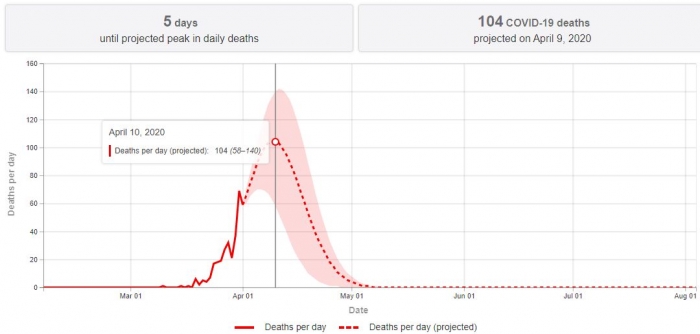
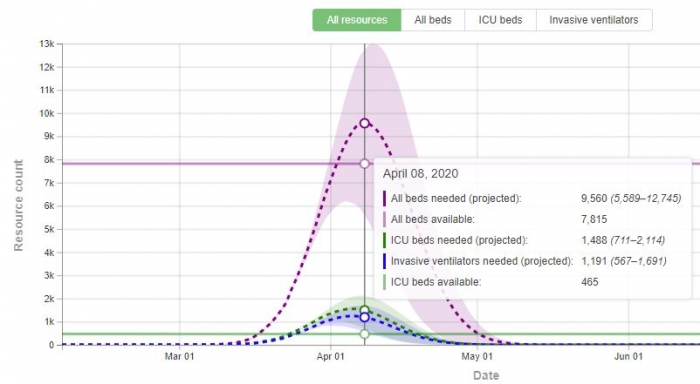



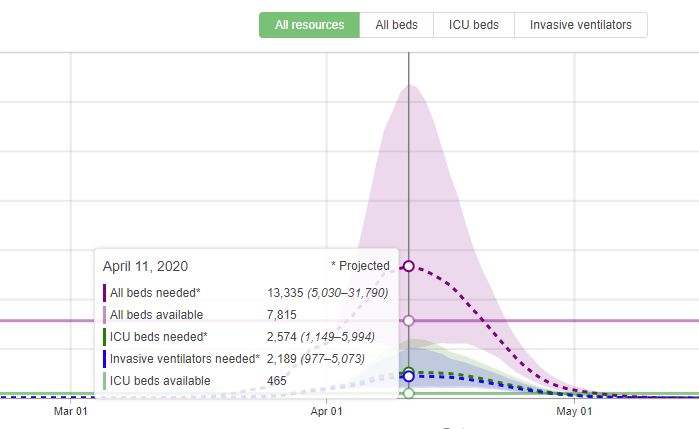





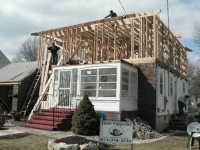
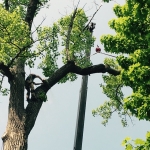



Interesting statistical models predicting peak for NY/NJ cases by April 10.
http://covid19.healthdata.org/projections
It seems optimistic, and a bit of a simplistic statistical model (e.g., it tails down to zero deaths after mid-July), but it may give a starting point for states to think about timing, needs, and approach.
However, in the FAQ, I found a very concerning caveat [in bold below]. It seems it is modeling only a "first" wave, and assumes only about 3% of the population will have been exposed to COVID-19 by June/July. I expect we will have a very strange summer as decisions are made around a potential 2nd wave.
Will we need social distancing until there is a vaccine?
Our model suggests that, with social distancing, the end of the first wave of the epidemic could occur by early June. The question of whether there will be a second wave of the epidemic will depend on what we do to avoid reintroducing COVID-19 into the population. By the end of the first wave of the epidemic, an estimated 97% of the population of the United States will still be susceptible to the disease and thus measures to avoid a second wave of the pandemic prior to vaccine availability will be necessary. Maintaining some of the social distancing measures could be supplemented or replaced by nation-wide efforts such as mass screening, contact tracing, and selective quarantine.